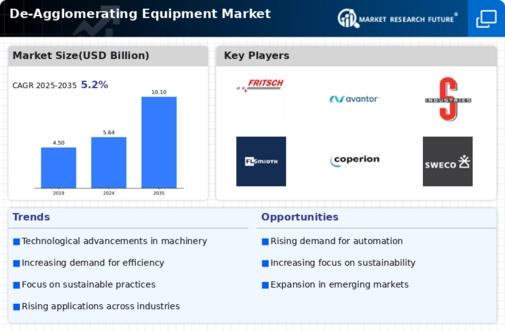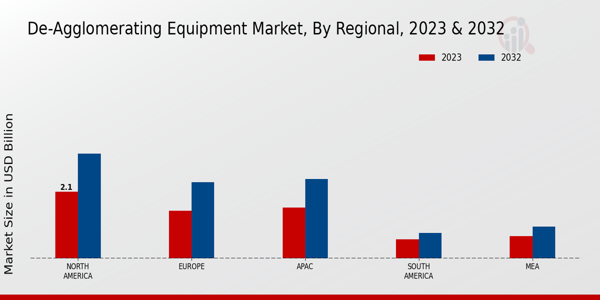Market Growth Projections
The Global De-Agglomerating Equipment Market Industry is projected to witness substantial growth, with estimates indicating a market value of 5.64 USD Billion in 2024 and a potential increase to 10.1 USD Billion by 2035. This growth trajectory suggests a compound annual growth rate of 5.47% from 2025 to 2035, highlighting the increasing importance of de-agglomeration processes across various sectors. The demand for efficient and effective de-agglomerating equipment is likely to rise as industries continue to prioritize product quality and operational efficiency.
Rising Demand for Fine Powders
The increasing demand for fine powders across various industries, such as pharmaceuticals, food processing, and chemicals, drives the Global De-Agglomerating Equipment Market Industry. As industries seek to enhance product quality and performance, the need for precise particle size distribution becomes paramount. For instance, the pharmaceutical sector requires fine powders for effective drug formulation, which necessitates advanced de-agglomerating equipment. This trend is expected to contribute to the market's growth, with projections indicating a market value of 5.64 USD Billion in 2024, reflecting the industry's shift towards more refined materials.
Growth in the Chemical Industry
The expansion of the chemical industry significantly influences the Global De-Agglomerating Equipment Market Industry. As the chemical sector continues to grow, driven by increased production and consumption of specialty chemicals, the demand for de-agglomerating equipment rises correspondingly. This equipment is essential for ensuring uniformity and consistency in chemical formulations, which is critical for product performance. The market is projected to experience a compound annual growth rate of 5.47% from 2025 to 2035, reflecting the ongoing need for efficient de-agglomeration solutions in the chemical manufacturing processes.
Technological Advancements in Equipment
Technological innovations in de-agglomerating equipment play a crucial role in shaping the Global De-Agglomerating Equipment Market Industry. The introduction of advanced technologies, such as high-energy milling and air classification, enhances the efficiency and effectiveness of de-agglomeration processes. These innovations not only improve product quality but also reduce operational costs, making them attractive to manufacturers. As companies increasingly adopt these technologies, the market is poised for growth, with expectations of reaching 10.1 USD Billion by 2035, indicating a robust trajectory driven by continuous advancements.
Regulatory Compliance and Quality Standards
Stringent regulatory compliance and quality standards across various industries propel the Global De-Agglomerating Equipment Market Industry. Industries such as pharmaceuticals and food processing are subject to rigorous regulations that mandate specific particle size distributions and product quality. As companies strive to meet these standards, the demand for reliable de-agglomerating equipment increases. This trend underscores the importance of investing in advanced technologies that ensure compliance while maintaining product integrity. Consequently, the market is expected to grow steadily, driven by the necessity for adherence to these regulations.
Sustainability and Environmental Considerations
The growing emphasis on sustainability and environmental considerations influences the Global De-Agglomerating Equipment Market Industry. Manufacturers are increasingly seeking eco-friendly solutions that minimize waste and energy consumption during the de-agglomeration process. This shift towards sustainable practices not only aligns with global environmental goals but also enhances operational efficiency. As industries adopt greener technologies, the demand for innovative de-agglomerating equipment that supports these initiatives is likely to rise. This trend may contribute to the overall growth of the market, reflecting a broader commitment to sustainability.











